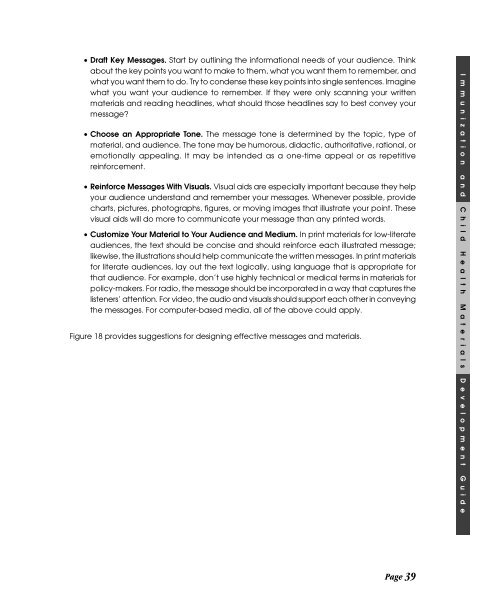Immunization and child health materials development guide pdf
Immunization and child health materials development guide pdf
Immunization and child health materials development guide pdf
Create successful ePaper yourself
Turn your PDF publications into a flip-book with our unique Google optimized e-Paper software.
• Draft Key Messages. Start by outlining the informational needs of your audience. Think<br />
about the key points you want to make to them, what you want them to remember, <strong>and</strong><br />
what you want them to do. Try to condense these key points into single sentences. Imagine<br />
what you want your audience to remember. If they were only scanning your written<br />
<strong>materials</strong> <strong>and</strong> reading headlines, what should those headlines say to best convey your<br />
message?<br />
• Choose an Appropriate Tone. The message tone is determined by the topic, type of<br />
material, <strong>and</strong> audience. The tone may be humorous, didactic, authoritative, rational, or<br />
emotionally appealing. It may be intended as a one-time appeal or as repetitive<br />
reinforcement.<br />
• Reinforce Messages With Visuals. Visual aids are especially important because they help<br />
your audience underst<strong>and</strong> <strong>and</strong> remember your messages. Whenever possible, provide<br />
charts, pictures, photographs, figures, or moving images that illustrate your point. These<br />
visual aids will do more to communicate your message than any printed words.<br />
• Customize Your Material to Your Audience <strong>and</strong> Medium. In print <strong>materials</strong> for low-literate<br />
audiences, the text should be concise <strong>and</strong> should reinforce each illustrated message;<br />
likewise, the illustrations should help communicate the written messages. In print <strong>materials</strong><br />
for literate audiences, lay out the text logically, using language that is appropriate for<br />
that audience. For example, don’t use highly technical or medical terms in <strong>materials</strong> for<br />
policy-makers. For radio, the message should be incorporated in a way that captures the<br />
listeners’ attention. For video, the audio <strong>and</strong> visuals should support each other in conveying<br />
the messages. For computer-based media, all of the above could apply.<br />
Figure 18 provides suggestions for designing effective messages <strong>and</strong> <strong>materials</strong>.<br />
Page 39

















